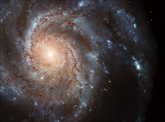  
     
Spiral Galaxy NGC 3370, Credit: Hubble (NASA/ESA), CFHT (Canada-France-Hawaii Telescope/J.-C. Cuillandre/Coelum, NOAO (G. Jacoby, B. Bohannan, M. Hanna/NOAO/
AURA/NSF. |
|
 |
|
|
|
2006 TEMPLETON PRIZE WINNER
 he purpose of the Templeton Prize is a simple one: to accelerate human progress toward understanding spiritual reality. By creating the Prize in 1972, Sir John wanted to emphasize the importance of increasing spiritual discoveries at the same rate as progress in other disciplines, such as medicine and cosmology. As science continues to show the universe in increasingly complex detail, so too does our awareness of spiritual realities need to grow. he purpose of the Templeton Prize is a simple one: to accelerate human progress toward understanding spiritual reality. By creating the Prize in 1972, Sir John wanted to emphasize the importance of increasing spiritual discoveries at the same rate as progress in other disciplines, such as medicine and cosmology. As science continues to show the universe in increasingly complex detail, so too does our awareness of spiritual realities need to grow.
In 2006, looking every inch the Cambridge don he is, mathematician John Barrow accepted the Templeton Prize in New York City with an eloquent address that linked both the cosmological and spiritual mysteries of the universe.
“The universe appears big and old, dark and cold, hostile to life as we know it, dangerous, and costly to explore. Many a philosopher of the past concluded that the universe was meaningless and antithetical to life: a bleak and black realm in which our little planet is a temporary outcome of the blind forces of Nature. Yet, appearances may again be deceptive.”
Barrow was nominated for the Prize by noted theologian Thomas Torrance (Templeton laureate 1978). In a detailed nomination letter he wrote of Barrow, “The hallmark of his work is a deep engagement with those aspects of the structure of the universe and its laws that make life possible and which shape the views that we take of that universe when we examine it. The vast elaboration of that simple idea has lead to a huge expansion of the breadth and depth of the dialogue between science and religion.”
Barrow’s writing includes more than 400 scientific papers, popular public lectures, and 17 books written in the accessible style of someone possessing both deep knowledge and enthusiasm for his subject. His writing has displayed an impressive depth and range, covering both nothingness in The Book of Nothing and the infinite in The Infinite Book: A Short Guide to the Boundless, Timeless, and Endless. As he wrote in The World Within the World, “The universe is full of magical things patiently waiting for our wits to grow sharper.” More than one reader interested in the intricacies of cosmology, science and how the universe created life has been thankful for Barrow’s wit and insight.
Barrow’s most influential book so far is The Anthropic Cosmological Principle, which he co-authored with Frank Tipler in 1986. Noted Torrance, “it drew together all the past natural theological thinking about design arguments and presented all the facts of the modern forms of the Anthropic arguments in cosmology, physics and chemistry. This work is amongst the most cited in the entire engagement between religion and science and it has spawned countless articles, reviews, books, conferences and research papers.”
While the Templeton Prize is 34 years old, the seeds for its eventual creation were first planted nearly 100 years ago. In 1901, Alfred Nobel created his now famous prizes for breakthroughs in fields such as physics, chemistry, medicine, literature and peace. Notably absent was a prize for religion. Perhaps, the famous inventor and businessman did not think that a breakthrough in religion was possible.
Sir John disagreed with the premise that progress could not occur in religion and, in 1973, he created the Templeton Prize for Progress in Religion, awarded annually to “a living individual who has shown extraordinary originality in research or discoveries to advance understanding of God and spiritual realities.” The Prize, now $1.4 million, is funded to provide recipients with a greater financial reward than does the Nobel Prize.
The first person the Foundation recognized for the pursuit of spiritual knowledge was Mother Teresa. Over the nearly three decades it has been given to a range of spiritual, religious and scientific visionaries. The Prize is not tied to a particular religious tradition and has been awarded to Jews, Christians, Muslims, Buddhists, as well as those with no formal religious affiliation. The multi-faith framework of the Prize calls for “a clearer acceptance of the diversity of gifts within the major religions of the world,” as Sir John said in 1972 while inaugurating plans for the awards.
Dr. Bruno Guiderdoni, Director of Research at the Institute of Astrophysics of the Centre National de la Recherche Scientifique (CNRS) in Paris and one of several past judges of the Templeton Prize says, “The Prize’s interdisciplinary nature is its greatest strength. It’s the only prize in the world that inspires these people to be a part of the great ideas that are going to influence this particular century.”
The Foundation encourages nominations from all interested parties. A panel of judges drawn from the major religions of the world consider the nominees’ contributions to progress in religion made either during the year prior to their nomination selection or during their entire career. Contributions are evaluated in terms of the individual’s creativity, innovation and effectiveness.
For more about the Templeton Prize, including nomination procedures,
visit www.templetonprize.org.
|
|
|